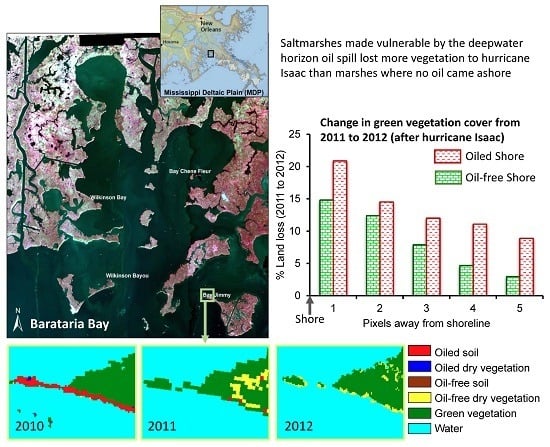Marsh Loss Due to Cumulative Impacts of Hurricane Isaac and the Deepwater Horizon Oil Spill in Louisiana
Abstract
:1. Introduction
2. Materials and Methods
2.1. Study Area
2.2. Remote Sensing Data
2.3. Measuring Impact: Vegetation Indices and Land Cover Change
2.4. Comparison Methods for Cumulative Impact of Oil and Hurricane on Vegetation
2.5. Effect of Site Characteristics on Vulnerability to Disturbances
3. Results
3.1. Cumulative Impact of Oil and Hurricane on Vegetation Indices
3.2. Cumulative Impact of Oil and Hurricane on Land Cover
3.3. Zone-Wise Impact Moving Inland from the Shore between Oiled and Oil-Free Shores
3.4. Effect of Landmass on Vulnerability to Impact
3.5. Effect of Post-Oil Treatment on Vulnerability to Impact
4. Discussion
4.1. Cumulative Effect of Oil Contamination and Hurricane Isaac
4.2. Effect of Landmass on Vulnerability of Oiled Shores
4.3. Effect of Post-Oil Treatment on the Vulnerability of Oiled Shores
5. Conclusions
Acknowledgments
Author Contributions
Conflicts of Interest
Abbreviations
| ADW1 | Absorption Depth of Water at 980 nm |
| ADW2 | Absorption Depth of Water at 1240 nm |
| ANOVA | ANalysis of VAriance |
| ARED | Angle formed at Red |
| AVIRIS | Airborne Visible/Infrared Imaging Spectrometer |
| DWH | Deep Water Horizon (oil spill) |
| GLM | Generalized Linear Models |
| JPL | Jet Propulsion Laboratory |
| MDP | Mississippi Deltaic Plain |
| mNDVI | modified Normalized Difference Vegetation Index |
| NASA | National Aeronautics and Space Administration |
| NDII | Normalized Difference Infrared Index |
| NDVI | Normalized Difference Vegetation Index |
| NPV | Non-Photosynthetic Vegetation |
References
- Meybeck, M. Global Analysis of River Systems: From Earth System Controls to Anthropocene Syndromes. Philos. Trans. R. Soc. Lond. B Biol. Sci. 2003, 358, 1935–1955. [Google Scholar] [CrossRef] [PubMed]
- Smith, V. Eutrophication of freshwater and coastal marine ecosystems a global problem. Environ. Sci. Pollut. Res. 2003, 10, 126–139. [Google Scholar] [CrossRef]
- Baumann, R.H.; Day, J.W.; Miller, C.A. Mississippi Deltaic Wetland Survival: Sedimentation Versus Coastal Submergence. Science 1984, 224, 1093–1095. [Google Scholar] [CrossRef] [PubMed]
- Ko, J.Y.; Day, J.W. A review of ecological impacts of oil and gas development on coastal ecosystems in the Mississippi Delta. Ocean Coast. Manag. 2004, 47, 597–623. [Google Scholar] [CrossRef]
- Cahoon, D.R.; Reed, D.J.; Day, J.W., Jr.; Steyer, G.D.; Roelof, M.B.; Lynch, J.C.; McNally, D.; Latif, N. The Influence of Hurricane Andrew on Sediment Distribution in Louisiana Coastal Marshes. J. Coast. Res. 1995, 21, 280–294. [Google Scholar]
- Guntenspergen, G.R.; Cahoon, D.R.; Grace, J.; Steyer, G.D.; Fournet, S.; Townson, M.A.; Foote, A.L. Disturbance and Recovery of the Louisiana Coastal Marsh Landscape from the Impacts of Hurricane Andrew. J. Coast. Res. 1995, 21, 324–339. [Google Scholar]
- Reed, D. Patterns of sediment deposition in subsiding coastal salt marshes, Terrebonne Bay, Louisiana: The role of winter storms. Estuaries 1989, 12, 222–227. [Google Scholar] [CrossRef]
- Reed, D.J. Sea-level rise and coastal marsh sustainability: Geological and ecological factors in the Mississippi delta plain. Geomo 2002, 48, 233–243. [Google Scholar] [CrossRef]
- Blum, M.D.; Roberts, H.H. The Mississippi Delta Region: Past, Present, and Future. AREPS 2012, 40, 655–683. [Google Scholar] [CrossRef]
- Blum, M.D.; Roberts, H.H. Drowning of the Mississippi Delta due to insufficient sediment supply and global sea-level rise. Nat. Geosci. 2009, 2, 488–491. [Google Scholar] [CrossRef]
- Day, J.; Britsch, L.; Hawes, S.; Shaffer, G.; Reed, D.; Cahoon, D. Pattern and process of land loss in the Mississippi Delta: A Spatial and temporal analysis of wetland habitat change. Estuaries 2000, 23, 425–438. [Google Scholar] [CrossRef]
- Day, J.W.; Boesch, D.F.; Clairain, E.J.; Kemp, G.P.; Laska, S.B.; Mitsch, W.J.; Orth, K.; Mashriqui, H.; Reed, D.J.; Shabman, L.; et al. Restoration of the Mississippi Delta: Lessons from Hurricanes Katrina and Rita. Science 2007, 315, 1679–1684. [Google Scholar] [CrossRef] [PubMed]
- Silliman, B.R.; van de Koppel, J.; McCoy, M.W.; Diller, J.; Kasozi, G.N.; Earl, K.; Adams, P.N.; Zimmerman, A.R. Degradation and resilience in Louisiana salt marshes after the BP–Deepwater Horizon oil spill. Proc. Natl. Acad. Sci. USA 2012, 109, 11234–11239. [Google Scholar] [CrossRef] [PubMed]
- White, W.A.; Tremblay, T.A. Submergence of Wetlands as a Result of Human-Induced Subsidence and Faulting along the upper Texas Gulf Coast. J. Coast. Res. 1995, 11, 788–807. [Google Scholar]
- Chabreck, R.H.; Palmisano, A.W. The Effects of Hurricane Camille on the Marshes of the Mississippi River Delta. Ecology 1973, 54, 1118–1123. [Google Scholar] [CrossRef]
- Stone, G.W.; Grymes, J.M., III; Dingler, J.R.; Pepper, D.A. Overview and Significance of Hurricanes on the Louisiana Coast, USA. J. Coast. Res. 1997, 13, 656–669. [Google Scholar]
- Keen, T.R.; Bentley, S.J.; Chad Vaughan, W.; Blain, C.A. The generation and preservation of multiple hurricane beds in the northern Gulf of Mexico. Mar. Geol. 2004, 210, 79–105. [Google Scholar] [CrossRef]
- Stone, G.W.; Liu, B.; Pepper, D.A.; Wang, P. The importance of extratropical and tropical cyclones on the short-term evolution of barrier islands along the northern Gulf of Mexico, USA. Mar. Geol. 2004, 210, 63–78. [Google Scholar] [CrossRef]
- Nyman, J.A.; Crozier, C.R.; DeLaune, R.D. Roles and Patterns of Hurricane Sedimentation in an Estuarine Marsh Landscape. ECSS 1995, 40, 665–679. [Google Scholar] [CrossRef]
- Rejmánek, M.; Sasser, C.E.; Peterson, G.W. Hurricane-induced sediment deposition in a gulf coast marsh. Estuar. Coast. Shelf Sci. 1988, 27, 217–222. [Google Scholar] [CrossRef]
- Nyman, J.A.; Walters, R.J.; Delaune, R.D.; Patrick, W.H., Jr. Marsh vertical accretion via vegetative growth. Estuar. Coast. Shelf Sci. 2006, 69, 370–380. [Google Scholar] [CrossRef]
- Turner, R.E.; Swenson, E.M.; Milan, C.S. Organic and Inorganic Contributions to Vertical Accretion in Salt Marsh Sediments. In Concepts and Controversies in Tidal Marsh Ecology; Weinstein, M.P., Kreeger, D.A., Eds.; Springer Netherlands: Dordrecht, The Netherlands, 2000; pp. 583–595. [Google Scholar]
- Lin, Q.; Mendelssohn, I.A.; Graham, S.A.; Hou, A.; Fleeger, J.W.; Deis, D.R. Response of salt marshes to oiling from the Deepwater Horizon spill: Implications for plant growth, soil surface-erosion, and shoreline stability. Sci. Total Environ. 2016, 557–558, 369–377. [Google Scholar] [CrossRef] [PubMed]
- Boochs, F.; Kupfer, G.; Dockter, K.; Kuhbauch, W. Shape of the red edge as vitality indicator for plants. Int. J. Remote Sens. 1990, 11, 1741–1753. [Google Scholar] [CrossRef]
- Bammel, B.H.; Birnie, R.W. Spectral Reflectance Response of Big Sagebrush to Hydrocarbon-Induced Stress in the Bighorn Basin, Wyoming; American Society for Photogrammetry and Remote Sensing: Bethesda, MD, USA, 1994; Volume 60. [Google Scholar]
- Li, L.; Ustin, S.L.; Lay, M. Application of AVIRIS data in detection of oil-induced vegetation stress and cover change at Jornada, New Mexico. Remote Sens. Environ. 2005, 94, 1–16. [Google Scholar] [CrossRef]
- Van Der Meer, F.; Van Dijk, P.; Van Der Werff, H.; Yang, H. Remote sensing and petroleum seepage: A review and case study. Terra Nova 2002, 14, 1–17. [Google Scholar] [CrossRef]
- Yang, H.; Zhang, J.; Van der Meer, F.; Kroonenberg, S.B. Geochemistry and field spectrometry for detecting hydrocarbon microseepage. Terra Nova 1998, 10, 231–235. [Google Scholar] [CrossRef]
- Turpie, K.R. Explaining the Spectral Red-Edge Features of Inundated Marsh Vegetation. J. Coast. Res. 2013, 29, 1111–1117. [Google Scholar] [CrossRef]
- Beland, M.; Roberts, D.A.; Peterson, S.H.; Biggs, T.W.; Kokaly, R.F.; Piazza, S.; Roth, K.L.; Khanna, S.; Ustin, S.L. Mapping changing distributions of dominant species in oil-contaminated salt marshes of Louisiana using imaging spectroscopy. Remote Sens. Environ. 2016, 182, 192–207. [Google Scholar] [CrossRef]
- Khanna, S.; Santos, M.J.; Ustin, D.S.L.; Koltunov, A.; Kokaly, R.F.; Roberts, D.A. Detection of salt marsh vegetation stress after the Deepwater Horizon BP oil spill along the shoreline of gulf of Mexico using AVIRIS data. PloS ONE 2013, 8, e78989. [Google Scholar] [CrossRef] [PubMed]
- Mishra, D.R.; Cho, H.J.; Ghosh, S.; Fox, A.; Downs, C.; Merani, P.B.T.; Kirui, P.; Jackson, N.; Mishra, S. Post-spill state of the marsh: Remote estimation of the ecological impact of the Gulf of Mexico oil spill on Louisiana Salt Marshes. Remote Sens. Environ. 2012, 118, 176–185. [Google Scholar] [CrossRef]
- Wang, W.; Qu, J.J.; Hao, X.; Liu, Y.; Stanturf, J.A. Post-hurricane forest damage assessment using satellite remote sensing. Agric. For. Meteorol. 2010, 150, 122–132. [Google Scholar] [CrossRef]
- Moss, L. The 13 largest oil spills in history. In Mother Nature Network; Narrative Content Group: Atlanta, GA, USA, 2010. [Google Scholar]
- Lin, Q.; Mendelssohn, I.A. Impacts and recovery of the Deepwater Horizon Oil Spill on vegetation structure and function of coastal salt marshes in the northern gulf of Mexico. Environ. Sci. Technol. 2012, 46, 3737–3743. [Google Scholar] [CrossRef] [PubMed]
- McClenachan, G.; Turner, R.E.; Tweel, A.W. Effects of oil on the rate and trajectory of Louisiana marsh shoreline erosion. Environ. Res. Lett. 2013, 8, 044030. [Google Scholar] [CrossRef]
- Ramsey, E., III; Rangoonwala, A.; Suzuoki, Y.; Jones, C.E. Oil detection in a coastal marsh with polarimetric Synthetic Aperture Radar (SAR). Remote Sens. 2011, 3, 2630–2662. [Google Scholar] [CrossRef] [Green Version]
- Kokaly, R.F.; Couvillion, B.R.; Holloway, J.M.; Roberts, D.A.; Ustin, S.L.; Peterson, S.H.; Khanna, S.; Piazza, S.C. Spectroscopic remote sensing of the distribution and persistence of oil from the Deepwater Horizon spill in Barataria Bay marshes. Remote Sens. Environ. 2013, 129, 210–230. [Google Scholar] [CrossRef]
- Peterson, S.H.; Roberts, D.A.; Beland, M.; Kokaly, R.F.; Ustin, S.L. Oil detection in the coastal marshes of Louisiana using MESMA applied to band subsets of AVIRIS data. Remote Sens. Environ. 2015, 159, 222–231. [Google Scholar] [CrossRef]
- Berg, R. Tropical Cyclone Report: Hurricane Isaac; National Hurricane Center, National Oceanic and Atmospheric Administration: Miami, FL, USA, 2013. [Google Scholar]
- Mo, Y.; Momen, B.; Kearney, M.S. Quantifying moderate resolution remote sensing phenology of Louisiana coastal marshes. Ecol. Model. 2015, 312, 191–199. [Google Scholar] [CrossRef]
- Wilson, C.A.; Allison, M.A. An equilibrium profile model for retreating marsh shorelines in southeast Louisiana. Estuar. Coast. Shelf Sci. 2008, 80, 483–494. [Google Scholar] [CrossRef]
- Gosselink, J.G.; Pendleton, E.C. The Ecology of Delta Marshes of Coastal Louisiana: A Community Profile; U.S. Fish and Wildlife Service: Washington, DC, USA, 1984; p. 156.
- Strassmann, M. The Fight over Keeping Oil out of Barataria Bay. Available online: http://www.cbsnews.com (accessed on 7 July 2010).
- Koltunov, A.; Ustin, S.L.; Quayle, B.; Schwind, B. GOES Early Fire Detection (GOES-EFD) system prototype. In Proceedings of the ASPRS 2012 Anuual Conference, Sacramento, CA, USA, 19–23 March 2012.
- Koltunov, A.; Ben-Dor, E.; Ustin, S.L. Image construction using multitemporal observations and Dynamic Detection Models. Int. J. Remote Sens. 2008, 30, 57–83. [Google Scholar] [CrossRef]
- Irani, M. Multi-frame correspondence estimation using subspace constraints. IJCV 2002, 48, 173–194. [Google Scholar] [CrossRef]
- Carter, G.A. Responses of Leaf Spectral Reflectance to Plant Stress. Am. J. Bot. 1993, 80, 239–243. [Google Scholar] [CrossRef]
- Ozesmi, S.; Bauer, M. Satellite remote sensing of wetlands. Wetlands Ecol. Manag. 2002, 10, 381–402. [Google Scholar] [CrossRef]
- Turner, R.E.; Rao, Y.S. Relationships between Wetland Fragmentation and Recent Hydrologic Changes in a Deltaic Coast. Estuaries 1990, 13, 272–281. [Google Scholar] [CrossRef]
- Tucker, C.J. Red and photographic infrared linear combinations for monitoring vegetation. Remote Sens. Environ. 1979, 8, 127–150. [Google Scholar] [CrossRef]
- Hunt, E.R.; Rock, B.N. Detection of changes in leaf water content using near-infrared and middle-infrared reflectances. Remote Sens. Environ. 1989, 30, 43–54. [Google Scholar]
- Gitelson, A.; Merzlyak, M.N. Spectral reflectance changes associated with autumn senescence of Aesculus-hippocastanum L. and Acer-platanoides L. leaves—Spectral features and relation to chlorophyll estimation. J. Plant Physiol. 1994, 143, 286–292. [Google Scholar] [CrossRef]
- Nagler, P.L.; Daughtry, C.S.T.; Goward, S.N. Plant litter and soil reflectance. Remote Sens. Environ. 2000, 71, 207–215. [Google Scholar] [CrossRef]
- Kruskal, W.H.; Wallis, W.A. Use of Ranks in One-Criterion Variance Analysis. J. Am. Stat. Assoc. 1952, 47, 583–621. [Google Scholar] [CrossRef]
- Khan, A.; Rayner, G.D. Robustness to Non-Normality of Common Tests for the Many-Sample Location Problem. J. Appl. Math. Decis. Sci. 2003, 7, 187–206. [Google Scholar] [CrossRef]
- McDonald, J.H. The Kruskal-Wallis Test. In Handbook of Biological Statistics; McDonald, J.H., Ed.; Sparky House Publishing Baltimore: Baltimore, MD, USA, 2009; Volume 2, pp. 158–165. [Google Scholar]
- McCullagh, P. Generalized linear models. Eur. J. Oper. Res. 1984, 16, 285–292. [Google Scholar] [CrossRef]
- Nelder, J.A.; Baker, R.J. Generalized Linear Models. In Encyclopedia of Statistical Sciences; John Wiley & Sons, Inc.: Hoboken, NJ, USA, 2004. [Google Scholar]
- Crawley, M.J. The R Book, 2nd ed.; Wiley: West Sussex, UK, 2013; p. 1051. [Google Scholar]
- Venables, W.N.; Dichmont, C.M. GLMs, GAMs and GLMMs: An overview of theory for applications in fisheries research. Fish. Res. 2004, 70, 319–337. [Google Scholar] [CrossRef]
- Bryant, J.; Chabreck, R. Effects of impoundment on vertical accretion of coastal marsh. Estuaries 1998, 21, 416–422. [Google Scholar] [CrossRef]
- Michel, J.; Owens, E.H.; Zengel, S.; Graham, A.; Nixon, Z.; Allard, T.; Holton, W.; Reimer, P.D.; Lamarche, A.; White, M.; et al. Extent and degree of shoreline oiling: Deepwater Horizon oil spill, Gulf of Mexico, USA. PLoS ONE 2013, 8, e65087. [Google Scholar] [CrossRef] [PubMed]
- Leifer, I.; Lehr, W.J.; Simecek-Beatty, D.; Bradley, E.; Clark, R.; Dennison, P.; Hu, Y.; Matheson, S.; Jones, C.E.; Holt, B.; et al. State of the art satellite and airborne marine oil spill remote sensing: Application to the BP Deepwater Horizon oil spill. Remote Sens. Environ. 2012, 124, 185–209. [Google Scholar] [CrossRef]
- van der Meijde, M.; van der Werff, H.M.A.; Jansma, P.F.; van der Meer, F.D.; Groothuis, G.J. A spectral-geophysical approach for detecting pipeline leakage. IJAEO 2009, 11, 77–82. [Google Scholar] [CrossRef]
- Kokaly, R.F.; Heckman, D.; Holloway, J.; Piazza, S.; Couvillion, B.; Steyer, G.D.; Mills, C.; Hoefen, T.M. Shoreline Surveys of Oil-Impacted Marsh in Southern Louisiana, July to August 2010; U.S. Geological Survey: Reston, VA, USA, 2011; p. 124.
- Zengel, S.; Bernik, B.M.; Rutherford, N.; Nixon, Z.; Michel, J. Heavily Oiled Salt Marsh following the Deepwater Horizon Oil Spill, Ecological Comparisons of Shoreline Cleanup Treatments and Recovery. PLoS ONE 2015, 10, e0132324. [Google Scholar] [CrossRef] [PubMed]
- Easterling, D.R.; Meehl, G.A.; Parmesan, C.; Changnon, S.A.; Karl, T.R.; Mearns, L.O. Climate Extremes: Observations, Modeling, and Impacts. Science 2000, 289, 2068–2074. [Google Scholar] [CrossRef] [PubMed]
- Lambert, S.J.; Fyfe, J.C. Changes in winter cyclone frequencies and strengths simulated in enhanced greenhouse warming experiments: Results from the models participating in the IPCC diagnostic exercise. ClDy 2006, 26, 713–728. [Google Scholar] [CrossRef]
- Ghosh, S.; Mishra, D.R.; Gitelson, A.A. Long-term monitoring of biophysical characteristics of tidal wetlands in the northern Gulf of Mexico—A methodological approach using MODIS. Remote Sens. Environ. 2016, 173, 39–58. [Google Scholar] [CrossRef]
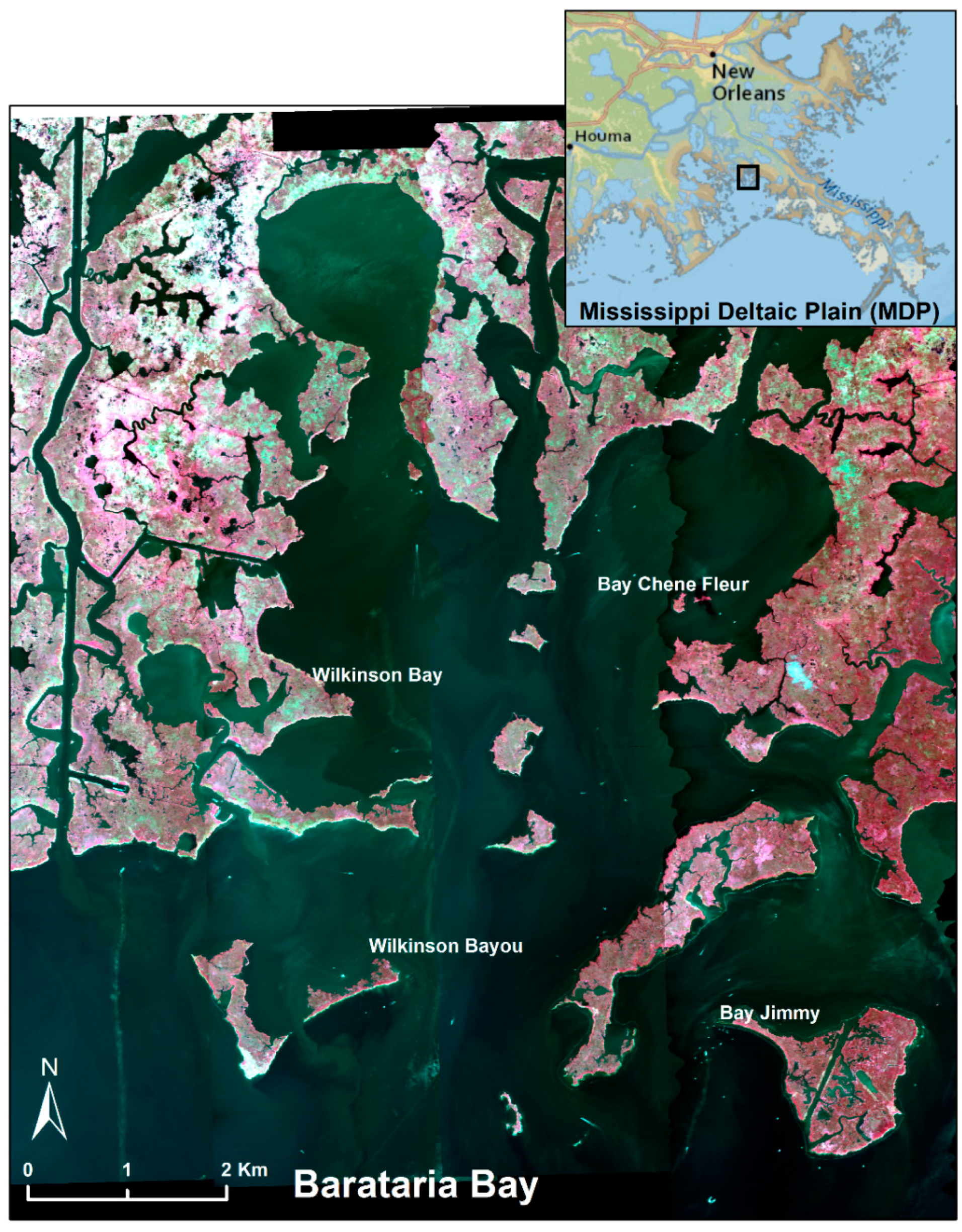
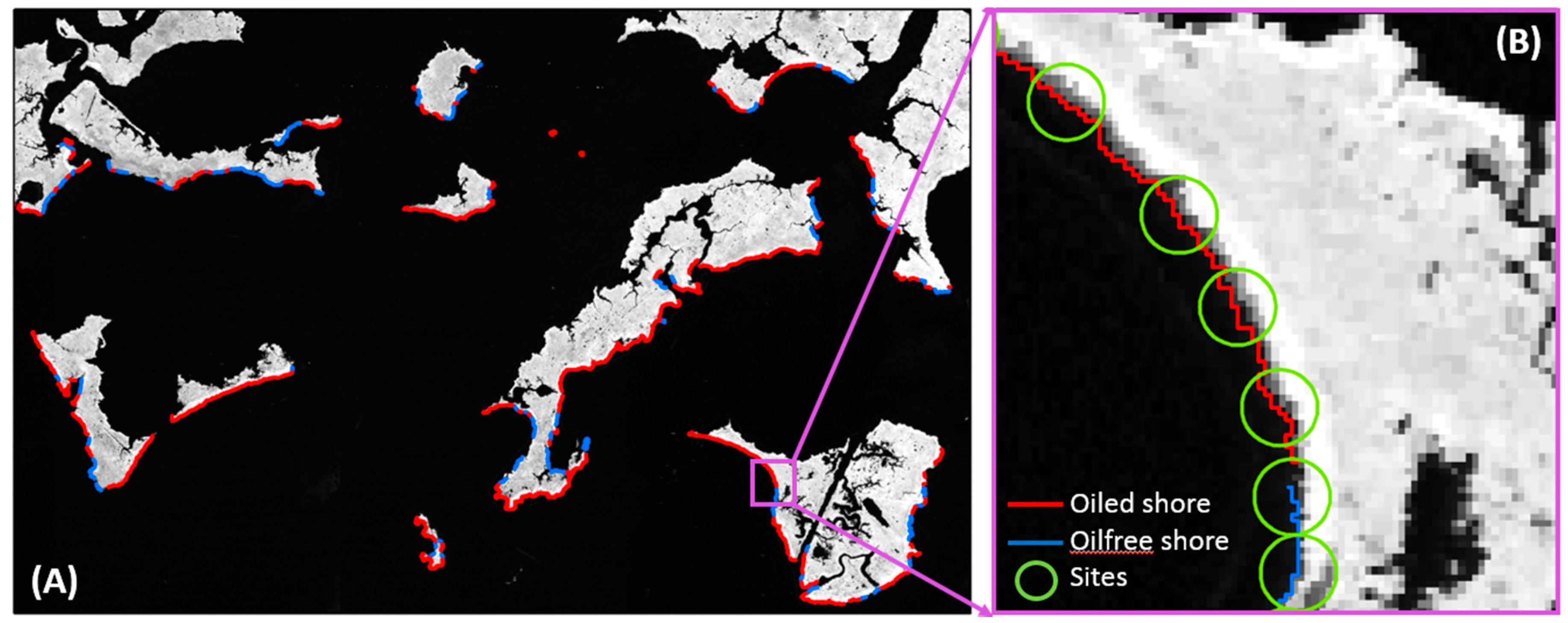
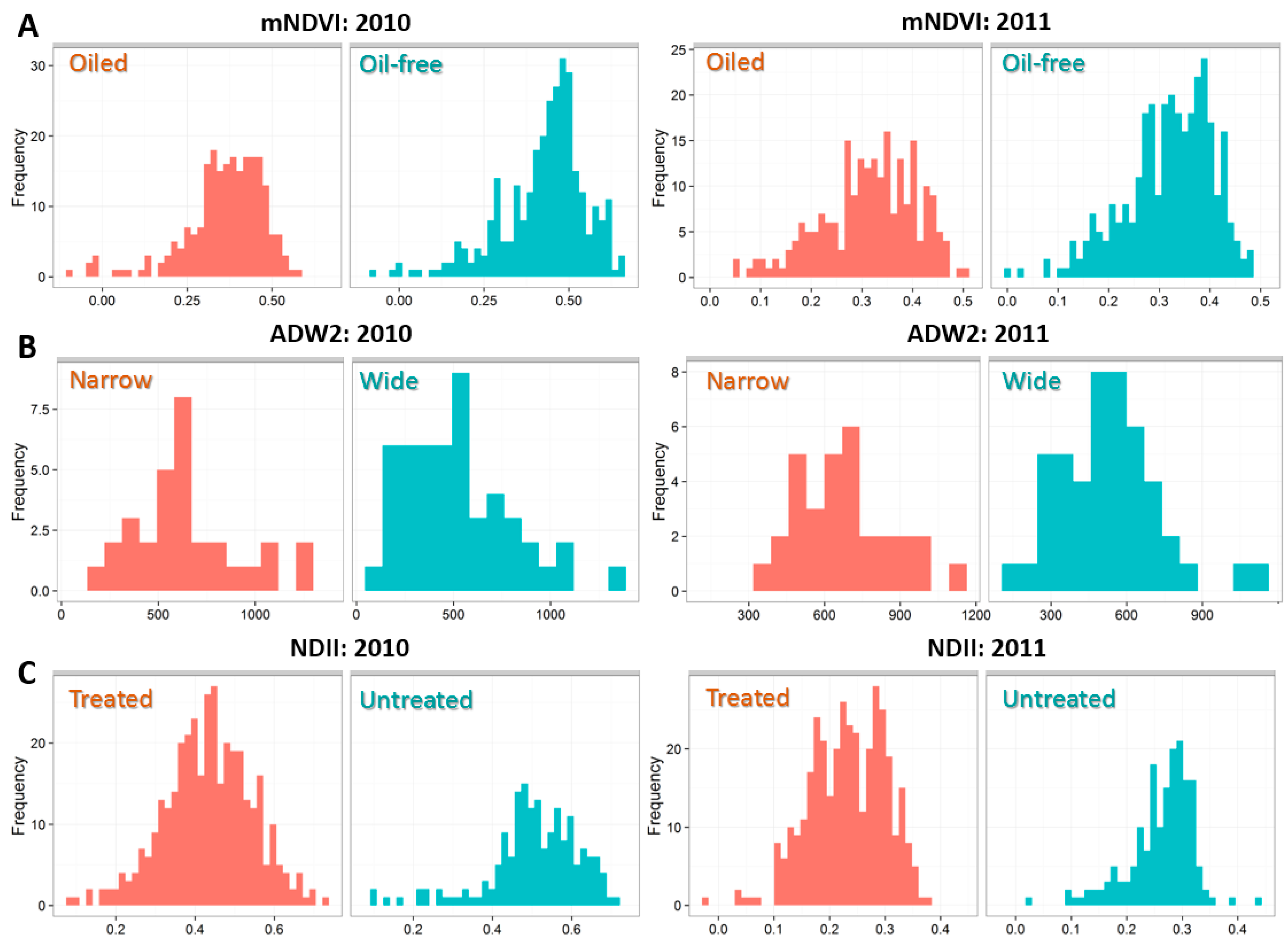
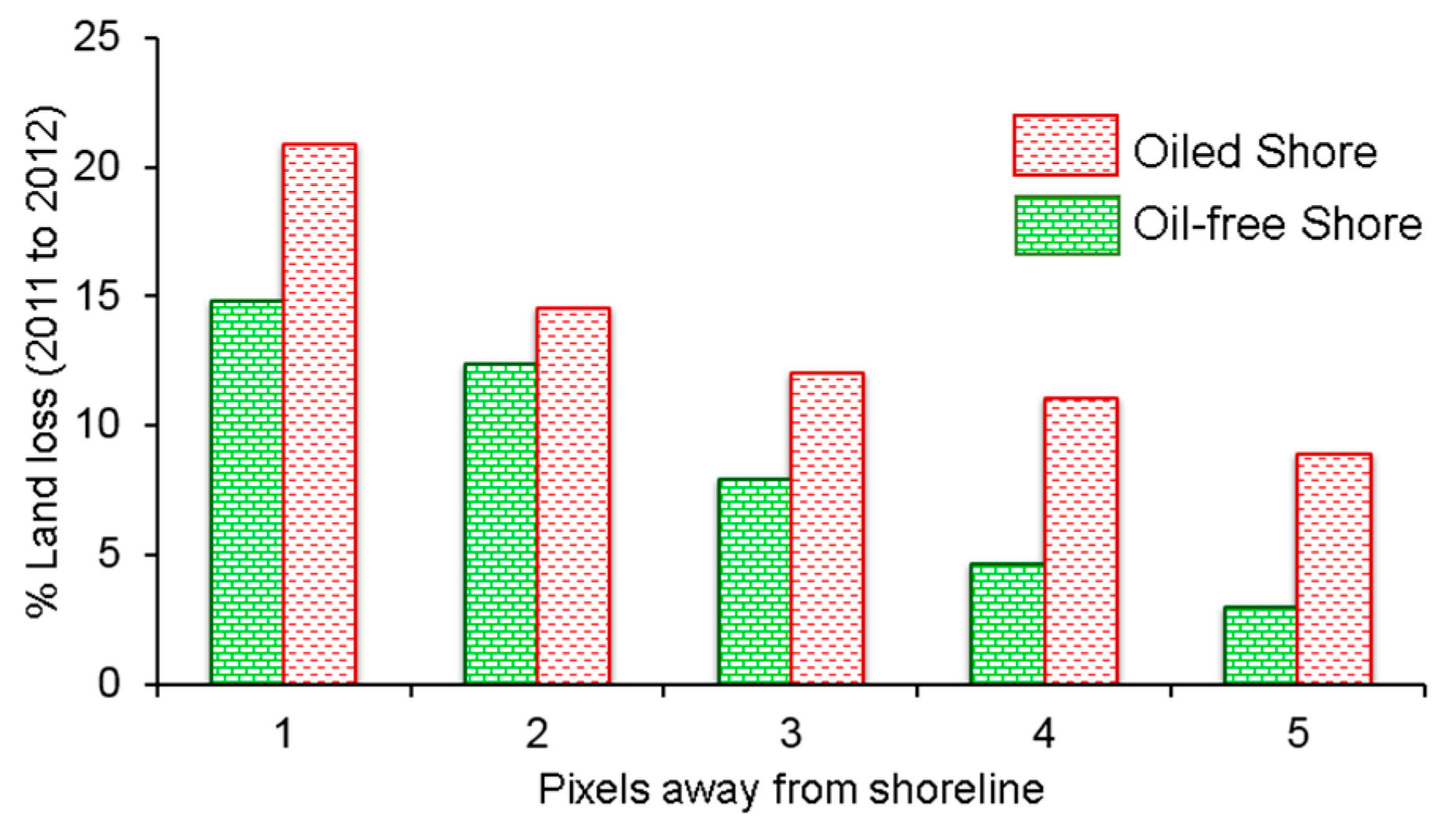
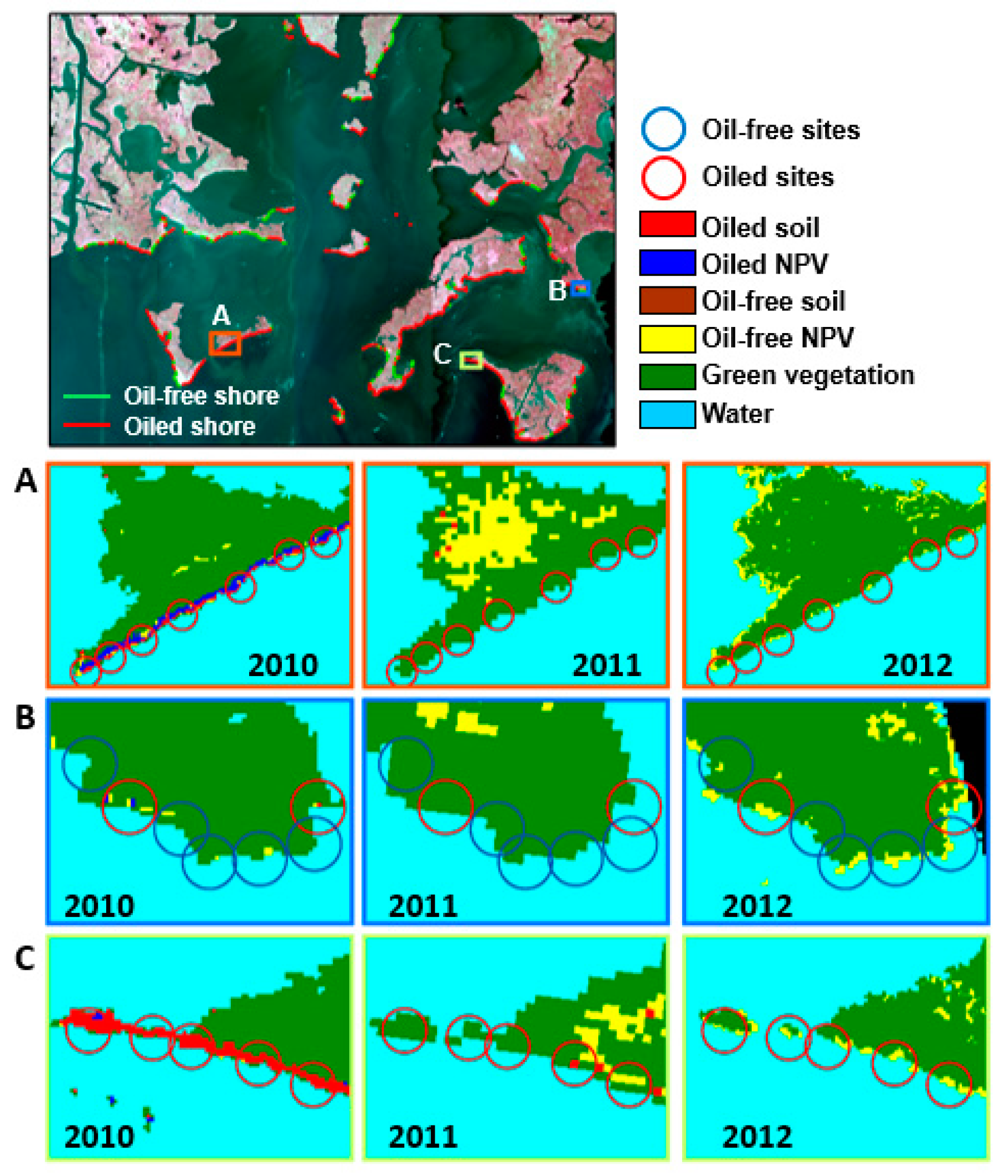
| Time (GMT) | Flight Date | Pixel Resolution (m) | Number of Flight Lines | Tide Level at Time of Image (m) |
|---|---|---|---|---|
| 18:57 | 14 September 2010 | 3.5 × 3.5 | 4 | 0.21 |
| 16:14 | 15 August 2011 | 7.7 × 7.7 | 2 | 0.25 |
| 15:06 | 19 October 2012 | 3.3 × 3.3 | 4 | 0.11 |
| 2010 | 2011 | 2012 | |
|---|---|---|---|
| oiled | 311 | 311 | 290 |
| narrow | 32 | 32 | 27 |
| wide | 50 | 50 | 50 |
| treated | 173 | 173 | 165 |
| untreated | 138 | 138 | 125 |
| oil-free | 225 | 225 | 215 |
| Variables | Description | |
|---|---|---|
| Indices | NDVI10/11/12 | Normalized Difference Vegetation Index: tracks vegetation health, pigment and abundance [51] |
| NDII10/11/12 | Normalized Difference Infrared Index: tracks plant health and water content [52] | |
| ARED10/11/12 | Angle at Red: tracks change in land cover and photosynthetic pigment [31] | |
| mNDVI10/11/12 | Modified NDVI or red-edge NDVI: sensitive to change in vegetation health, pigment and abundance [53] | |
| ADW110/11/12 | Absorption Depth of Water at 980 nm: sensitive to plant water content [31,54] | |
| ADW210/11/12 | Absorption Depth of Water at 1240 nm: sensitive to plant water content [31,54] | |
| Land Cover/Change Metrics | pveg_10/11/12 | Number of green vegetation pixels at each site for each year/total pixels at each site for each year (%) |
| psnpv_10/11/12 | Number of dry vegetation pixels at each site for each year/total pixels at each site for each year (%) | |
| pwat_10/11/12 | Number of water pixels at each site for each year/total pixels at each site for each year (%) | |
| Δgveg_10_11 | pveg_11-pveg_10 1 | |
| Δgveg_11_12 | pveg_12-pveg_11 | |
| Δwat_10_11 | pwat_11-pwat_10 | |
| Δwat_11_12 | pwat_12-pwat_11 | |
| Δsnpv_10_11 | psnpv_11-psnpv_10 | |
| Δsnpv_11_12 | psnpv_12-psnpv_11 |
| Mean | Standard Deviation | Difference | Kruskal–Wallis | ||||
|---|---|---|---|---|---|---|---|
| Index | Oiled | Oil-Free | Oiled | Oil-Free | in Medians | H | p-Value |
| NDVI10 | 0.527 | 0.627 | 0.138 | 0.125 | 0.090 | 102.36 | <0.0001 |
| NDII10 | 0.422 | 0.503 | 0.113 | 0.106 | 0.081 | 74.90 | <0.0001 |
| ARED10 | 4.795 | 5.204 | 0.544 | 0.371 | 0.385 | 77.93 | <0.0001 |
| mNDVI10 | 0.356 | 0.457 | 0.120 | 0.113 | 0.098 | 107.00 | <0.0001 |
| ADW110 | 293.8 | 365.5 | 126.9 | 107.4 | 81.2 | 51.80 | <0.0001 |
| ADW210 | 606.2 | 701.2 | 264.5 | 221.3 | 129.5 | 29.52 | <0.0001 |
| NDVI11 | 0.531 | 0.539 | 0.109 | 0.094 | 0.007 | 0.12 | 0.7275 |
| NDII11 | 0.318 | 0.317 | 0.093 | 0.083 | −0.004 | 0.24 | 0.6263 |
| ARED11 | 0.868 | 0.795 | 0.366 | 0.266 | −0.050 | 2.71 | 0.0998 |
| mNDVI11 | 5.094 | 5.050 | 0.435 | 0.332 | −0.093 | 6.27 | 0.0123 |
| ADW111 | 404.6 | 389.2 | 141.2 | 125.6 | −16.8 | 0.90 | 0.3416 |
| ADW211 | 643.8 | 653.5 | 177.2 | 146.7 | 18.4 | 0.65 | 0.4219 |
| NDVI12 | 0.310 | 0.357 | 0.169 | 0.120 | 0.032 | 6.77 | 0.0093 |
| NDII12 | 0.528 | 0.516 | 0.136 | 0.120 | −0.032 | 2.21 | 0.1373 |
| ARED12 | 3.958 | 4.040 | 0.490 | 0.380 | 0.079 | 4.38 | 0.0365 |
| mNDVI12 | 0.207 | 0.244 | 0.132 | 0.099 | 0.035 | 6.85 | 0.0089 |
| ADW112 | 134.8 | 147.0 | 58.6 | 50.0 | 11.4 | 4.19 | 0.0407 |
| ADW212 | 465.8 | 503.7 | 156.9 | 137.3 | 21.4 | 4.62 | 0.0315 |
| Land Cover | Mean | Standard Deviation | Slope | Intercept | ||||
|---|---|---|---|---|---|---|---|---|
| Change Metric | Oiled | Oil-Free | Oiled | Oil-Free | Z-Value | p-Value | Z-Value | p-Value |
| pveg_10 | 36.31 | 50.85 | 14.88 | 15.44 | −8.87 | <0.001 | 9.57 | <0.001 |
| pwat_10 | 43.10 | 46.96 | 13.21 | 15.43 | −2.97 | 0.003 | 4.24 | <0.001 |
| psnpv_10 | 20.58 | 2.24 | 11.12 | 3.84 | 10.75 | <0.001 | −9.95 | <0.001 |
| pveg_11 | 57.69 | 57.68 | 21.40 | 20.69 | 0.01 | 0.992 | 1.65 | 0.100 |
| pwat_11 | 40.89 | 41.97 | 21.47 | 20.68 | −0.56 | 0.573 | 2.69 | 0.007 |
| psnpv_11 | 1.38 | 0.36 | 4.80 | 1.59 | 2.57 | 0.010 | 3.88 | <0.001 |
| Δgveg_10_11 | 21.39 | 6.83 | 22.58 | 19.07 | 6.87 | <0.001 | −0.12 | 0.905 |
| Δwat_10_11 | −2.22 | −4.99 | 19.40 | 18.55 | 1.60 | 0.109 | 5.01 | <0.001 |
| Δsnpv_10_11 | −19.20 | −1.88 | 12.15 | 4.34 | −10.69 | <0.001 | −8.89 | <0.001 |
| pveg_12 | 40.26 | 42.20 | 22.58 | 21.54 | −0.96 | 0.335 | 3.12 | 0.002 |
| pwat_12 | 49.56 | 45.36 | 22.36 | 19.08 | 2.18 | 0.030 | −0.07 | 0.944 |
| psnpv_12 | 10.21 | 12.49 | 7.69 | 9.00 | −3.00 | 0.003 | 5.19 | 0.001 |
| Δgveg_11_12 | −17.43 | −15.48 | 19.89 | 16.85 | −1.15 | 0.251 | 2.88 | 0.004 |
| Δwat_11_12 | 8.67 | 3.40 | 20.44 | 16.15 | 3.03 | 0.002 | 3.63 | <0.001 |
| Δsnpv_11_12 | 8.83 | 12.13 | 8.96 | 8.67 | −3.98 | <0.001 | 5.99 | <0.001 |
| Mean | Standard Deviation | Difference | Kruskal–Wallis | ||||
|---|---|---|---|---|---|---|---|
| Index | Wide | Narrow | Wide | Narrow | In Medians | H | p-Value |
| NDVI10 | 0.545 | 0.372 | 0.121 | 0.176 | −0.141 | 35.81 | <0.0001 |
| NDII10 | 0.427 | 0.377 | 0.109 | 0.131 | −0.075 | 5.29 | 0.0215 |
| ARED10 | 4.835 | 4.442 | 0.484 | 0.850 | −0.305 | 5.73 | 0.0167 |
| mNDVI10 | 0.372 | 0.219 | 0.105 | 0.150 | −0.140 | 31.70 | <0.0001 |
| ADW110 | 305.6 | 191.1 | 121.6 | 128.0 | −116.7 | 19.05 | <0.0001 |
| ADW210 | 626.4 | 430.5 | 261.5 | 225.8 | −160.8 | 16.38 | 0.0001 |
| NDVI11 | 0.541 | 0.430 | 0.103 | 0.123 | −0.085 | 23.39 | <0.0001 |
| NDII11 | 0.325 | 0.253 | 0.090 | 0.097 | −0.068 | 14.62 | 0.0001 |
| ARED11 | 0.836 | 1.177 | 0.335 | 0.496 | 0.209 | 18.48 | <0.0001 |
| mNDVI11 | 5.091 | 5.118 | 0.444 | 0.350 | −0.002 | 0.00 | 0.9843 |
| ADW111 | 412.8 | 326.0 | 135.8 | 168.9 | −98.2 | 13.45 | 0.0002 |
| ADW211 | 660.1 | 487.3 | 167.6 | 193.2 | −186.3 | 25.01 | <0.0001 |
| NDVI12 | 0.331 | 0.114 | 0.150 | 0.221 | −0.236 | 27.78 | <0.0001 |
| NDII12 | 0.527 | 0.534 | 0.136 | 0.135 | 0.060 | 0.26 | 0.6077 |
| ARED12 | 3.961 | 3.926 | 0.498 | 0.407 | 0.054 | 0.09 | 0.7706 |
| mNDVI12 | 0.221 | 0.066 | 0.119 | 0.169 | −0.176 | 22.71 | <0.0001 |
| ADW112 | 138.0 | 103.5 | 58.4 | 51.5 | −37.0 | 8.62 | 0.0033 |
| ADW212 | 482.3 | 305.0 | 146.8 | 163.6 | −210.1 | 23.38 | <0.0001 |
| Land Cover | Mean | Standard Deviation | Slope | Intercept | ||||
|---|---|---|---|---|---|---|---|---|
| Change Metric | Narrow | Wide | Narrow | Wide | Z-Value | p-Value | Z-Value | p-Value |
| pveg_10 | 19.65 | 38.15 | 13.88 | 13.31 | 5.73 | <0.001 | −2.32 | 0.021 |
| pwat_10 | 59.32 | 41.31 | 11.87 | 13.84 | −6.17 | <0.001 | 7.67 | <0.001 |
| psnpv_10 | 21.10 | 20.52 | 11.15 | 11.03 | −0.28 | 0.783 | 5.71 | <0.001 |
| pveg_11 | 40.71 | 59.58 | 20.43 | 22.78 | 4.35 | <0.001 | 0.25 | 0.799 |
| pwat_11 | 59.06 | 38.88 | 20.38 | 22.79 | −4.59 | <0.001 | 7.62 | <0.001 |
| psnpv_11 | 0.26 | 1.50 | 5.03 | 1.44 | 1.17 | 0.240 | 10.96 | <0.001 |
| Δgveg_10_11 | 21.06 | 21.43 | 22.94 | 19.42 | 0.08 | 0.933 | 8.44 | <0.001 |
| Δwat_10_11 | −0.26 | −2.43 | 19.77 | 15.82 | −0.59 | 0.554 | 11.58 | <0.001 |
| Δsnpv_10_11 | −20.84 | −19.01 | 12.27 | 11.01 | 0.79 | 0.427 | 6.61 | <0.001 |
| pveg_12 | 19.61 | 42.55 | 21.97 | 17.10 | 4.94 | <0.001 | 2.09 | 0.037 |
| pwat_12 | 70.52 | 47.24 | 21.50 | 19.06 | −5.07 | <0.001 | 7.84 | <0.001 |
| psnpv_12 | 9.94 | 10.24 | 7.79 | 6.83 | 0.21 | 0.836 | 6.89 | <0.001 |
| Δgveg_11_12 | −21.10 | −17.03 | 20.14 | 17.40 | 1.08 | 0.279 | 8.62 | <0.001 |
| Δwat_11_12 | 11.45 | 8.36 | 20.94 | 15.26 | −0.80 | 0.424 | 10.55 | <0.001 |
| Δsnpv_11_12 | 9.68 | 8.73 | 9.14 | 7.20 | −0.56 | 0.577 | 8.28 | <0.001 |
| Mean | Standard deviation | Difference | Kruskal–Wallis | ||||
|---|---|---|---|---|---|---|---|
| Index | Treated | Untreated | Treated | Untreated | In Medians | H | p-Value |
| NDVI10 | 0.527 | 0.528 | 0.118 | 0.160 | 0.019 | 2.03 | 0.1544 |
| NDII10 | 0.402 | 0.447 | 0.100 | 0.123 | 0.055 | 15.74 | 0.0001 |
| ARED10 | 4.692 | 4.923 | 0.492 | 0.580 | 0.394 | 20.44 | <0.0001 |
| mNDVI10 | 0.344 | 0.371 | 0.106 | 0.134 | 0.054 | 10.02 | 0.0015 |
| ADW110 | 266.5 | 328.1 | 107.0 | 141.2 | 82.7 | 20.31 | <0.0001 |
| ADW210 | 543.4 | 684.9 | 219.4 | 294.4 | 136.7 | 19.09 | <0.0001 |
| NDVI11 | 0.521 | 0.543 | 0.113 | 0.104 | 0.023 | 3.06 | 0.0804 |
| NDII11 | 0.313 | 0.325 | 0.094 | 0.092 | 0.012 | 1.52 | 0.2174 |
| ARED11 | 0.930 | 0.789 | 0.408 | 0.287 | −0.122 | 8.52 | 0.0035 |
| mNDVI11 | 5.054 | 5.144 | 0.491 | 0.347 | 0.022 | 0.53 | 0.4682 |
| ADW111 | 394.5 | 417.4 | 136.8 | 146.2 | 29.3 | 2.43 | 0.1188 |
| ADW211 | 622.8 | 670.7 | 184.8 | 163.7 | 62.6 | 5.45 | 0.0196 |
| NDVI12 | 0.280 | 0.351 | 0.169 | 0.161 | 0.055 | 18.50 | <0.0001 |
| NDII12 | 0.514 | 0.547 | 0.140 | 0.128 | 0.044 | 5.42 | 0.0199 |
| ARED12 | 3.832 | 4.123 | 0.428 | 0.517 | 0.439 | 29.62 | <0.0001 |
| mNDVI12 | 0.176 | 0.247 | 0.132 | 0.122 | 0.068 | 25.40 | <0.0001 |
| ADW112 | 122.3 | 151.3 | 56.0 | 58.0 | 29.3 | 17.75 | <0.0001 |
| ADW212 | 435.5 | 505.8 | 147.7 | 160.3 | 73.6 | 16.68 | <0.0001 |
| Land Cover | Mean | Standard Deviation | Slope | Intercept | ||||
|---|---|---|---|---|---|---|---|---|
| Change Metric | Treated | Untreated | Treated | Untreated | Z-Value | p-Value | Z-Value | p-Value |
| pveg_10 | 34.17 | 38.98 | 14.54 | 14.91 | −2.80 | 0.005 | 3.31 | <0.001 |
| pwat_10 | 42.18 | 44.26 | 12.64 | 13.85 | −1.38 | 0.168 | 1.89 | 0.059 |
| psnpv_10 | 23.67 | 16.70 | 10.59 | 10.58 | 5.28 | <0.001 | −3.98 | <0.001 |
| pveg_11 | 57.96 | 57.36 | 21.58 | 21.25 | 0.24 | 0.807 | 0.46 | 0.646 |
| pwat_11 | 40.10 | 41.88 | 21.53 | 21.43 | −0.73 | 0.468 | 1.56 | 0.119 |
| psnpv_11 | 1.96 | 0.65 | 5.81 | 2.98 | 2.21 | 0.027 | 1.20 | 0.230 |
| Δgveg_10_11 | 23.79 | 18.38 | 22.17 | 22.82 | 2.09 | 0.037 | 0.00 | 0.997 |
| Δwat_10_11 | −2.08 | −2.38 | 18.09 | 21.00 | 0.14 | 0.891 | 1.98 | 0.047 |
| Δsnpv_10_11 | −21.71 | −16.04 | 12.58 | 10.83 | −3.99 | <0.001 | −2.45 | 0.014 |
| pveg_12 | 38.23 | 42.82 | 21.36 | 23.86 | −1.78 | 0.075 | 2.50 | 0.013 |
| pwat_12 | 50.80 | 48.01 | 21.53 | 23.35 | 1.09 | 0.274 | −0.19 | 0.850 |
| psnpv_12 | 11.01 | 9.20 | 7.85 | 7.39 | 2.04 | 0.041 | −0.47 | 0.641 |
| Δgveg_11_12 | −19.73 | −14.54 | 17.40 | 22.36 | −2.26 | 0.024 | −0.03 | 0.977 |
| Δwat_11_12 | 10.70 | 6.13 | 18.96 | 21.97 | 1.95 | 0.052 | 1.07 | 0.286 |
| Δsnpv_11_12 | 9.05 | 8.55 | 9.90 | 7.65 | 0.49 | 0.628 | 1.07 | 0.284 |
© 2017 by the authors. Licensee MDPI, Basel, Switzerland. This article is an open access article distributed under the terms and conditions of the Creative Commons Attribution (CC BY) license ( http://creativecommons.org/licenses/by/4.0/).
Share and Cite
Khanna, S.; Santos, M.J.; Koltunov, A.; Shapiro, K.D.; Lay, M.; Ustin, S.L. Marsh Loss Due to Cumulative Impacts of Hurricane Isaac and the Deepwater Horizon Oil Spill in Louisiana. Remote Sens. 2017, 9, 169. https://doi.org/10.3390/rs9020169
Khanna S, Santos MJ, Koltunov A, Shapiro KD, Lay M, Ustin SL. Marsh Loss Due to Cumulative Impacts of Hurricane Isaac and the Deepwater Horizon Oil Spill in Louisiana. Remote Sensing. 2017; 9(2):169. https://doi.org/10.3390/rs9020169
Chicago/Turabian StyleKhanna, Shruti, Maria J. Santos, Alexander Koltunov, Kristen D. Shapiro, Mui Lay, and Susan L. Ustin. 2017. "Marsh Loss Due to Cumulative Impacts of Hurricane Isaac and the Deepwater Horizon Oil Spill in Louisiana" Remote Sensing 9, no. 2: 169. https://doi.org/10.3390/rs9020169





